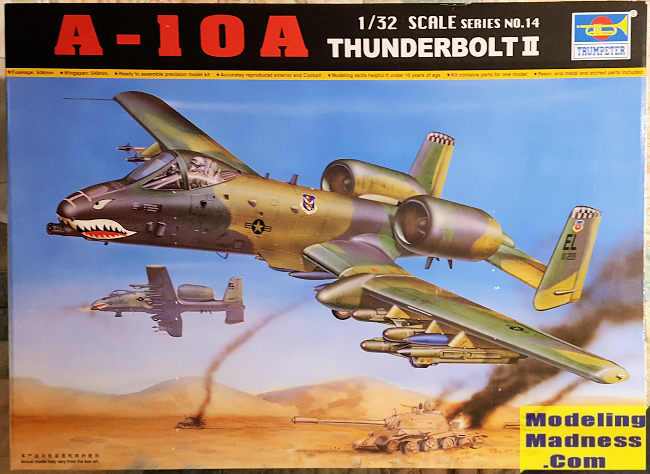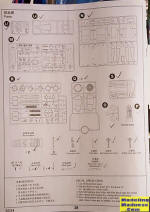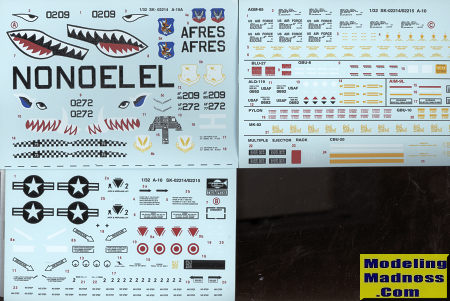
| KIT #: | 02214 |
| PRICE: | $150.00 SRP |
| DECALS: | Two options |
| REVIEWER: | Scott Van Aken |
| NOTES: | 2011 Release |

| HISTORY |
The Fairchild Republic A-10 Thunderbolt II is a single-seat, twin turbofan engine, straight wing jet aircraft developed by Fairchild-Republic for the United States Air Force (USAF). It is commonly referred to by the nicknames "Warthog" or "Hog", although the A-10's official name comes from the Republic P-47 Thunderbolt, a World War II fighter-bomber effective at attacking ground targets. The A-10 was designed for close air support (CAS) of friendly ground troops, attacking armored vehicles and tanks, and providing quick-action support against enemy ground forces. It entered service in 1976 and is the only production-built aircraft that has served in the USAF that was designed solely for CAS. Its secondary mission is to provide forward air controller – airborne (FAC-A) support, by directing other aircraft in attacks on ground targets. Aircraft used primarily in this role are designated OA-10.
The A-10 was intended to improve on the performance of the A-1 Skyraider and its lesser firepower. The A-10 was designed around the 30 mm GAU-8 Avenger rotary cannon. Its airframe was designed for durability, with measures such as 1,200 pounds (540 kg) of titanium armor to protect the cockpit and aircraft systems, enabling it to absorb a significant amount of damage and continue flying. Its short takeoff and landing capability permits operation from airstrips close to the front lines, and its simple design enables maintenance with minimal facilities. The A-10 served in the Gulf War (Operation Desert Storm), the American led intervention against Iraq's invasion of Kuwait, where the A-10 distinguished itself. The A-10 also participated in other conflicts such as in Grenada, the Balkans, Afghanistan, Iraq, and against Islamic State in the Middle East.
The A-10A single-seat variant was the only version produced, though one pre-production airframe was modified into the YA-10B twin-seat prototype to test an all-weather night capable version. In 2005, a program was started to upgrade remaining A-10A aircraft to the A-10C configuration, with modern avionics for use with precision weaponry. The U.S. Air Force had stated the F-35 would replace the A-10 as it entered service, but this remains highly contentious within the USAF and in political circles. With a variety of upgrades and wing replacements, the A-10's service life can be extended to 2040; the service has no planned retirement date as of June 2017.
| THE KIT |

 To
say there was a lot of excitement when this kit was announced would be an
understatement. The A-10 is a type beloved by a considerable number of modelers
and to have it in this scale was like a dream come true. Once it was released
the picking of nits began and while the kit isn't perfect (as in the canopy is
too tall), it isn't the horrible mess that some would have you believe.
Basically, all it really needs are a replacement canopy (Squadron) and perhaps
some belts for the very visible seat.
To
say there was a lot of excitement when this kit was announced would be an
understatement. The A-10 is a type beloved by a considerable number of modelers
and to have it in this scale was like a dream come true. Once it was released
the picking of nits began and while the kit isn't perfect (as in the canopy is
too tall), it isn't the horrible mess that some would have you believe.
Basically, all it really needs are a replacement canopy (Squadron) and perhaps
some belts for the very visible seat.
For a kit this size, doing a single fuselage half would not be the wisest move in terms of possible warping so Trumpeter molded it in a front and rear section. At this time, having movable stuff (just like the '60s) was considered important so all the control surfaces have the ability to be moved. You also get two very nicely tooled resin engines so that opening the cowlings will show them off. They also add a ton of weight behind the wheels necessitating a whopping 80 grams of weight in the nose. This weight is supposed to fit inside the ammo drum for the nose cannon, but good luck getting it in there. There is some space around it so all of this area will be required.
To hold all this up, metal landing gear are provided with the tires being rubber that slip on the wheels. Other metal bits are a some hinges, the mirror assembly, pitot tube, boarding ladder and locking bits for the engine cowlings. There is also a resin bang seat. Some of the engine and engine shroud parts are in clear plastic, which I guess is a plus if you want to display the engine.
For those interested this is the updated version after the initial production aircraft as it has the nose and fin antennas. You would expect a lot of the kit is pylons and armament and you definitely get that. For a rundown you get two Sidewinders with their pylon, an ALQ-119 jammer pod, BLU-27 napalm bomb, GBU-10, GBU-8 laser guided bombs, CBU-52 cluster bomb, Mk.20 cluster bomb, a ton of Mk.82 iron bombs with MER, AGM-65 Maverick and mounts along with a pair of large fuel tanks. That should be enough to make it look busy. A load out diagram is also provided.
 Instructions
are well done and actually make the build look easy. Color information is
generic except of the exterior in which FS 595 references are provided. Both
markings options are in the Euro 1 scheme as shown on the box art. The box art
plane is with the 75th TFS/23 TFW 'Flying Tigers' while the other is with the
706 TFS with the hog nose. Decal sheets are nicely printed and you get weapons
markings as well. If you don't like those options, there are aftermarket sheets
to help you with many of the other units that fly or flew the plane. Be advised
that if you do anything too new with those sheets you'll need to find at least a
GPS antenna. To do an earlier plane you'll have to sand off some antennas.
Instructions
are well done and actually make the build look easy. Color information is
generic except of the exterior in which FS 595 references are provided. Both
markings options are in the Euro 1 scheme as shown on the box art. The box art
plane is with the 75th TFS/23 TFW 'Flying Tigers' while the other is with the
706 TFS with the hog nose. Decal sheets are nicely printed and you get weapons
markings as well. If you don't like those options, there are aftermarket sheets
to help you with many of the other units that fly or flew the plane. Be advised
that if you do anything too new with those sheets you'll need to find at least a
GPS antenna. To do an earlier plane you'll have to sand off some antennas.
| CONCLUSIONS |
So there you have it. None of its various 'faults' is unfixable and the end result is a really big model for your display area. Those who have built it have found that it actually goes together fairly well, but one does have to take their time to be sure of proper fit before going on to the next step.
| REFERENCES |
https://en.wikipedia.org/wiki/Fairchild_Republic_A-10_Thunderbolt_II
May 2019
Copyright ModelingMadness.com. All rights reserved.
Thanks to Mark
for the review kit. If you would like your product reviewed fairly and
fairly quickly, please
contact
the editor or see other details in the
Note to
Contributors. Back to the Main Page
Back to the Review
Index Page
Back to the Previews Index Page